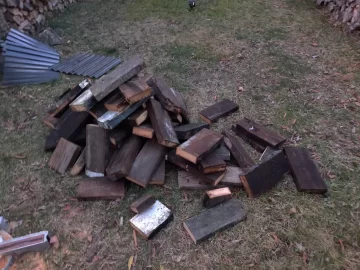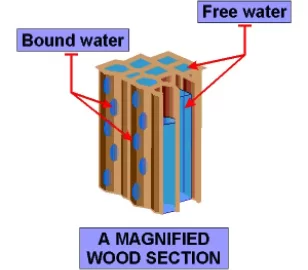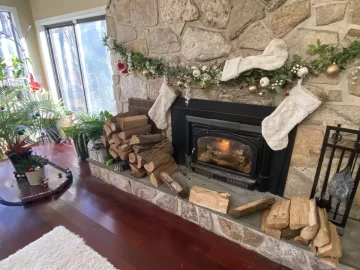I've seen some really sappy construction wood. So you have any issues with getting stuff that is not dry enough?All of my kindling is scrap construction wood. I split and fill up a barrel in my basement. Gets me through the winter.
What if you had to burn High MC wood?
- Thread starter Garbanzo62
- Start date
-
Active since 1995, Hearth.com is THE place on the internet for free information and advice about wood stoves, pellet stoves and other energy saving equipment.
We strive to provide opinions, articles, discussions and history related to Hearth Products and in a more general sense, energy issues.
We promote the EFFICIENT, RESPONSIBLE, CLEAN and SAFE use of all fuels, whether renewable or fossil.
You are using an out of date browser. It may not display this or other websites correctly.
You should upgrade or use an alternative browser.
You should upgrade or use an alternative browser.
Question on the Bio Bricks... What sizes are they sold in beside pallet full. I don't think I have inside storage for a full pallet. Are they 10 in a bundle, 12 etc. and what would be a reasonable price.
shortys7777
Minister of Fire
I've been doing it for years for my stove and camp fires. bought 2x4 and what not are usually all kiln dried. Never had an issue. I've also cut up pallets and split those to use. I've burned pallet wood in my stove with wet wood my first year starting out. They are everywhere for free by me in RII've seen some really sappy construction wood. So you have any issues with getting stuff that is not dry enough?
weatherguy
Minister of Fire
Every time I drive by a construction site, I load up my vehicle with scraps. Usually, every year I also buy a pallet of compressed bricks even if my wood is seasoned nicely.All of my kindling is scrap construction wood. I split and fill up a barrel in my basement. Gets me through the winter.
nola mike
Minister of Fire
j7art2
Minister of Fire
Chimney fires are a real possibility, BUT...
Stacking at least 4 days worth by the stove, and keeping that supply by the stove at all times, always burning the oldest and driest, would do a lot. We keep a face cord by the stove, and it is much drier after 2-3 days than when we brought it in. After 4 days it's real dry. This is not fresh split, and has usually been stacked for a year or more, but you can tell the difference. A piece of fresh wood by the stove will usually be dry enough to burn well in 4-5 days, depending on species. A friend on mine is short on wood this year and I told him the same thing, stack it by the stove.
+1 to this. Mine only holds 2 days, and I rotate the wettest pieces to the bottom or lean them against the ash pan lip to dry them quicker. I'm drying out semi punky 7 year seasoned oak and maple doing exactly this and intend to do this to all of my wood as I don't have a wood shed and all my wood is exposed to the elements. It works!
Sawset
Minister of Fire
They come in 20 bricks per pack, 2 lbs each - 40lbs per package.Question on the Bio Bricks... What sizes are they sold in beside pallet full. I don't think I have inside storage for a full pallet. Are they 10 in a bundle, 12 etc. and what would be a reasonable price.
By pallet they are about ~6$ each, retail at big y is 6.99.
I just picked up a pallet of a bricks this weekend. Not Bio Bricks, but similar.They come in 20 bricks per pack, 2 lbs each - 40lbs per package.
By pallet they are about ~6$ each, retail at big y is 6.99.
Packs were 2 lb bricks, 16 to a pack, so 32 lbs per pack
Contained 62 packs for a total of 1,984 lbs
Cost was $230, so 11.6 cents per lb
This is a second home and I only burn on weekends during the winter. Figured I'd save my growing firewood supply for summer campfires and stick to burning these for convenience.
twcronin
New Member
+1 on this. Lots of people will tell you not to bother, but it is highly dependent on particulars, including: i) do you have dry kindling? ii) can you do hot reloads much of the time and modify what your burn cycles look like? iii) what is the draft and airflow like on your stove? iv) what species of wood? (and possibly some other questions too). We burned about 2 cords of wood last winter, much less-than-ideally dry. No buildup issues says the sweep, almost every fire burned down clean to ash with no soot on the glass, and we got plenty of heat (about halved our oil usage relative to before the stove). We had enough dry wood to get fires started, were around mostly to do hot reloads, have a very strong draft and (for better or worse) no airflow control on our MF Nova, and a sizeable fraction of the wood was ash which burns pretty well even when not very seasoned (low green MC and ignites well). If you get a hot reload right with wet wood you might hear sizzling but you shouldn't see much smoke coming out of the chimney.The first year the wood we had was wet. Outside, in the rain, snow covered kind of wet. We ran the stove a lot with the damper open, and with the door propped open. One lesson learned was, that you can burn sloppy wet wood, and it won't hurt anything, if you keep the stack temp high, in this case 400-600deg. We couldn't get those temps any higher, because it just would not. We checked every month that the stainless chimney was staying clean. It was. We had no issues, other than that it produced marginal heat, was a bugger to get lit, difficult to stay lit, difficult to keep a consistent burn etc etc etc. We did it, didn't know better at the time, worked with what we had, and were determined to get some wood socked away for the future.
The energy penalty from burning wet wood is not very large, so long as you can get the wood to ignite, at least on its outer layers, rather quickly. Cellulose is about 16 MJ/kg of energy when you burn it cleanly. Water is 2.5 MJ/kg to vaporize. A 10% increase in moisture content is thus only about 0.25 MJ penalty, or around 1.5% of the heat you'll get out of the kg of bone dry wood. But, if the wood won't ignite, then you'll lose a much larger fraction than that as heat up the chimney while you've got the door and or damper wide open. If it smolders for a long time with a low stove temperature, you'll lose a lot more than 1.5% energy as unburned gases out the top of the stack (and risk creosote buildup). Getting wood to ignite quickly and not smolder in a cold stove is where a hot start with dry kindling, the wood species (as mentioned by other posters), as well as the hot reload, and probably strong airflow, all combine. You can get most of the heat out of the wood still, but you will need to modify your firecraft and may need to do frequent, small reloads on big beds of hot coals -- the ideal of running long combustion cycles with full reloads and low air for sure will not fly with very wet wood.
Drying wood for a few days near the stove -- as mentioned by many here -- will do a heck of a lot for drying the outer layers of the wood, which will make it ignite much more easily even if the interior is still quite wet.
Finally: don't recall if you have a stove with a catalyst but be careful about burning a lot of construction residue that may have galvanized nails in it.
Love this!The energy penalty from burning wet wood is not very large, so long as you can get the wood to ignite, at least on its outer layers, rather quickly. Cellulose is about 16 MJ/kg of energy when you burn it cleanly. Water is 2.5 MJ/kg to vaporize. A 10% increase in moisture content is thus only about 0.25 MJ penalty, or around 1.5% of the heat you'll get out of the kg of bone dry wood. But, if the wood won't ignite, then you'll lose a much larger fraction than that as heat up the chimney while you've got the door and or damper wide open. If it smolders for a long time with a low stove temperature, you'll lose a lot more than 1.5% energy as unburned gases out the top of the stack (and risk creosote buildup). Getting wood to ignite quickly and not smolder in a cold stove is where a hot start with dry kindling, the wood species (as mentioned by other posters), as well as the hot reload, and probably strong airflow, all combine. You can get most of the heat out of the wood still, but you will need to modify your firecraft and may need to do frequent, small reloads on big beds of hot coals -- the ideal of running long combustion cycles with full reloads and low air for sure will not fly with very wet wood.
Energy expenditure is not linear - ie, more of the energy will go towards vaporizing water at the start of combustion process than towards end. So that 0.25MJ will impact the earlier phase of combustion than later. Energy lost is also more than just vaporize, consider energy takes to heat the steam to flue temperature.
Energy release is also not linear. Non-cat stove's greatest asset is secondary combustion. If the off gas cools off lower than ignite temperature needed for secondary combustion, the 16 MJ/kg figure also lowers. Others please chip in - but for me the greatest heat output is the secondary. If I miss this chance, the energy output will spread-out much longer period of time.
So when the heat output of wood is low (when trying to ignite it), the wasteful energy expenditure is also highest.... so we are now forced to ask a stove to operate beyond the optimum range to compensate for these losses.
Edit: "Energy production" -> "Energy release"
Last edited:
So I brought a bunch into the garage as they were calling for snow last week. I grabbed about 8 pieces of the Ash I cut in August. It was still High 20s low 30s. Split it small and stacked it next to the insert for 2 days. It caught fire right away. Only mixed it in with other seasoned stuff. and used the small pieces to fill in. Got some more drying now. Wish I had more space to do bigger stacks.
Tested some other Ash that I cut at the same time and it was reading between 16 and 19. A few 30+ pieces, but I can tell by the weight which ones those are. Burning a load right now 90% Ash and 10% oak slabwood.
Real PIA trying to husband the resources this first year. I should be all set next year. Still a few trees that fell a few weeks ago to cut up and a lot of standing dead to cut. Going to see if the sawmill has more slabwood available after Xmas. Hopefully I can augment the burnable pile
Tested some other Ash that I cut at the same time and it was reading between 16 and 19. A few 30+ pieces, but I can tell by the weight which ones those are. Burning a load right now 90% Ash and 10% oak slabwood.
Real PIA trying to husband the resources this first year. I should be all set next year. Still a few trees that fell a few weeks ago to cut up and a lot of standing dead to cut. Going to see if the sawmill has more slabwood available after Xmas. Hopefully I can augment the burnable pile
GrumpyDad
Minister of Fire
OH how easily we forget! You just reminded me, my intended new wood pile location was a river about 6 years ago after receiving 8+ inches of rain one memorial day weekend. Yikes. I better change my plans this spring.We’ve all been there. One year I had my dry wood wash away in a spring flood. That fall I had the replacement wood wash away.
Free pallets are dry and easy to mix in with some of the wetter wood. Compressed sawdust blocks are easily available. Ask some friends if they have any spare wood.
Lastly, you can burn the wetter wood, but it will be frustrating and it will foul the chimney. Keep the air open more than usual. It isn’t ideal, but either is being cold.
I’d try to mix a marginal split or 2 in with the dry each load. It’ll stretch the dry out as far as possible.
GrumpyDad
Minister of Fire
My palm tree is envious of your palm trees location
Fod01
Feeling the Heat
+1 on that....mine's in the basement under a grow lamp. Its not thrilled.My palm tree is envious of your palm trees location
I like to burn wood period. Never tried the compressed bricks. Just burn what you have. If they work for you, then thats good. I just like burning real wood. The work, the effort , the storing, the burning.......all of it. Ad the camp fire smell....golden to me, brings back memories!
Picked up two more loads of Slabwood. Guestimating about 1.2 cords. $40 for each load, plus $66 for truck rental (don't own a pickup) and another 11 for gas. So a little over $150 in total. Now I just need to cut it to length check MC and stack. Hoping at least half of it is burnable now.
They had some planks in the pile. Grabbed a few of those, must be 1 X 14 at least. Probably will not burn those but make something like a n outdoor work table. You can see one dead center on the bottom of the pile.
![IMG_0395[1].JPG IMG_0395[1].JPG](https://www.hearth.com/talk/data/attachments/306/306391-7d0ecfc00543d4fb319a7e52a06b2317.jpg)
![IMG_0395[1].JPG IMG_0395[1].JPG](https://www.hearth.com/talk/data/attachments/306/306391-7d0ecfc00543d4fb319a7e52a06b2317.jpg)
They had some planks in the pile. Grabbed a few of those, must be 1 X 14 at least. Probably will not burn those but make something like a n outdoor work table. You can see one dead center on the bottom of the pile.
![IMG_0395[1].JPG IMG_0395[1].JPG](https://www.hearth.com/talk/data/attachments/306/306391-7d0ecfc00543d4fb319a7e52a06b2317.jpg)
![IMG_0395[1].JPG IMG_0395[1].JPG](https://www.hearth.com/talk/data/attachments/306/306391-7d0ecfc00543d4fb319a7e52a06b2317.jpg)
Last edited:
Similar threads
- Replies
- 44
- Views
- 2K
- Replies
- 28
- Views
- 4K
- Replies
- 28
- Views
- 2K
- Replies
- 9
- Views
- 2K




